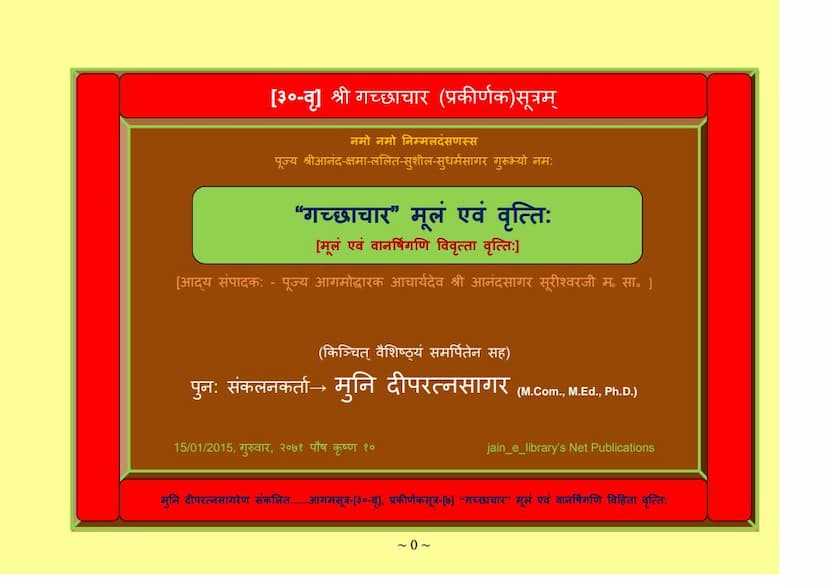Aagam 30 V GACHCHHAACHAAR Moolam Evam Vrutti
Added to library: September 1, 2025

Summary
This is a comprehensive summary of the Jain text "Gachchhāchār" (Book 30 V, Prakirṇakastūtra-7), based on the provided text excerpts:
Book Title: Gachchhāchār Moolam evam Vrutti (गच्छाचार मूलं एवं वृत्ति:) Author(s): Dipratnasagar, Deepratnasagar (Munishri Deepratnasagar) Publisher: Deepratnasagar (as per the catalog link) / Aagamoday Samiti (as per the title page) Original Work: Gachchhāchār Prakirṇakastūtra (गच्छाचार प्रकीर्णकसूत्र) Commentary (Vrutti): Written by Vanarshiganivijayavimalganijisūriśvarjī, with initial editing and compilation by Acharya Shri Anandasagar Surishwarji. Current Compilation: By Munishri Deepratnasagar, who has also added his own "Deep Anukram" (a unique indexing system).
Core Purpose and Content:
The "Gachchhāchār Prakirṇakastūtra" is a Jain scripture that primarily deals with the conduct, rules, and proper behavior (āchār) expected within Jain monastic communities, referred to as "Gachchhas" (congregations or orders). The text, along with its detailed commentary, aims to:
- Define and Guide Monastic Life: It outlines the essential principles and practices that govern the lives of monks and nuns, ensuring adherence to the Jain path to liberation (moksha).
- Distinguish Right Conduct from Wrong Conduct: A significant portion of the text focuses on identifying and condemning behaviors and attitudes that deviate from the true Jain path, often referred to as "unmārg" (wrong path) or "asmārg" (incorrect path).
- Emphasize the Importance of a True Guru/Acharya: The text repeatedly stresses the crucial role of a virtuous and knowledgeable Acharya (spiritual leader) in guiding the community and the disciple. It provides detailed descriptions of the qualities of an ideal Acharya and the characteristics of a flawed or false Acharya.
- Explain the Benefits of Right Association: It highlights the positive impact of living in a righteous Gachchha (community) with virtuous individuals and the severe consequences of associating with those who follow the wrong path.
- Detail Monastic Duties and Virtues: The text expounds on various aspects of monastic life, including:
- Knowledge (Jnana): The importance of studying and understanding scriptures.
- Conduct (Chāritra): Adherence to vows, restraint over senses, and following established monastic practices (samāyārī).
- Penance/Austerities (Tapas): The role of various forms of penance in purifying the soul.
- Righteous Living: Living a life free from attachment and aversion, with detachment towards worldly possessions and relationships.
- Right Association: Choosing virtuous companions and avoiding those with negative influences.
- Careful Conduct: Practicing non-violence (ahimsā) meticulously in all actions, even towards microscopic beings.
- Proper Eating and Possessions: Strict adherence to rules regarding food intake, the use of monastic requisites (upadhi), and avoiding greed.
- Etiquette and Respect: Maintaining proper decorum, respecting elders and superiors, and engaging in edifying conversation.
- Purity of Intention and Action: The importance of right intention and action in all monastic activities.
- Dealing with Mistakes: Proper procedures for confession and expiation of faults.
Key Themes and Concepts:
- Mangaḷ (Auspiciousness): The text begins with auspicious greetings and invocations, a common practice in Jain scriptures.
- Upāyopēya Bhāva (Means and End): The text discusses the relationship between the means (proper conduct) and the ultimate end (liberation).
- Unmārg vs. Sanmārg (Wrong Path vs. Right Path): A central theme is the stark contrast between following the true teachings of the Tirthankaras and deviating into erroneous paths driven by ignorance, ego, or worldly desires.
- Qualities of an Acharya: The text elaborates extensively on the ideal Acharya, describing them as a pillar of support, a guiding light, and a protector of the community. It also details the negative traits of misguided spiritual leaders who lead their followers astray.
- The Importance of Purity in Conduct: Throughout the text, there's a strong emphasis on maintaining purity in thoughts, words, and deeds, especially in interactions with the opposite sex and in adhering to monastic regulations.
- Consequences of Wrongdoing: The text warns of the severe karmic consequences, including being reborn in lower realms, for those who deviate from the right path or follow corrupt spiritual leaders.
- The Value of Righteous Company: It highlights that residing in a righteous Gachchha leads to spiritual progress and purification, while association with the unrighteous leads to downfall.
- The Significance of Scriptures: The text underscores the importance of studying and understanding the scriptures as the foundation for right conduct.
Structure and Presentation:
- Moola and Vritti: The text presents the original verses (Moola) followed by a detailed commentary (Vritti).
- Verse Structure: The verses are primarily in Prakrit, with the commentary explaining them in Sanskrit and Prakrit, often elaborating on specific terms and concepts with examples from Jain lore.
- Indexing: Munishri Deepratnasagar has added his unique "Deep Anukram" which helps in navigating the text, linking it to other Jain publications.
- Footnotes: Some pages contain footnotes clarifying printing or numbering errors, or providing additional explanations on specific topics.
Overall Significance:
"Gachchhāchār" serves as a vital guide for Jain monks and nuns, providing them with a clear framework for maintaining their spiritual discipline and community integrity. It acts as a critical tool for self-reflection and discernment, enabling practitioners to identify and avoid pitfalls on the path to liberation by understanding and adhering to the timeless teachings of Jainism. The compilation by Munishri Deepratnasagar makes this important text accessible to a wider audience through digital publication.